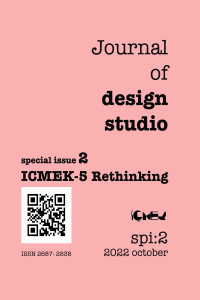An Introduction to Design Studio Experience: The Process, Challenges and Opportunities
An Introduction to Design Studio Experience: The Process, Challenges and Opportunities
Design studio, parametric design thinking computational design approach, design education,
___
- Chan, C. S. (2012). Phenomenology of rhythm in design. Frontiers of Architectural Research, 1(3), 253-258.
- Betancourt, M. C., Quintero, L. M., & Cereceda, G. (2014). A Discussion on Algorithmic Thinking in Product Design Process. In DS 77: Proceedings of the DESIGN 2014, 13th International Design Conference, 1035-1042.
- Denning, P. (2009). The profession of IT beyond computational thinking. Communications of the ACM, 52(6), 28-30. doi:10.1145/1516046.1516054.
- Hacihasanoglu, O. (2019). Architectural Design Studio Culture, Journal of Design Studio, 1(1), 5-15.
- Jackson, P. (2011). Folding Techniques for Designers-From Sheet to Form. Laurence King Publishing.
- Koch, A., Schwennsen, K., Dutton, T.A., Smith, D. (2002). The Redesign of Studio Culture: A Report of the AIAS Studio Culture Task Force, Washington DC.
- Laban, R. (n.d.) Labanotation (online). Available at: https://labaninstitute.org/about/laban-movement-analysis/ (accessed 04 July 2020). 2
- Lebée, A. (2015). From folds to structures, a review. International journal of space structures, 30(2), 55-74.
- Milovanovic, J., & Gero, J. (2020). Modeling design studio pedagogy: A mentored reflective practice. In Proceedings of the Design Society: DESIGN Conference (Vol. 1, pp. 1765-1774). Cambridge University Press.
- Oh, Y., Ishizaki, S., Gross, M. D., & Do, E. Y. L. (2013). A theoretical framework of design critiquing in architecture studios. Design Studies, 34(3), 302-325.
- Oxman, R. (2017). Thinking difference: Theories and models of parametric design thinking. Design Studies, 52, 4-39.
- Purcell, A.T. and Gero, J.S. (1998). “Drawings and the design process”, Design Studies, 19(4), 389-430.
- Rowe, P. G. (1987). Design thinking. MIT Press.
- Saulnier, C. R., Bagiati, A., & Brisson, J. G. (2016). A comparison of student design activity preferences before and after a design-based wilderness education experience. In Proceedings of the 2016 ASEE Annual Conference & Exposition.
- Schön, D.A. (1985). The Design Studio, RIBA, London.
- Stewart, I. (2007). Mathematics: some assembly needed. Nature, Vol. 448, No. 7152, pp. 419.
- Stiny, G. (2006). Shape: talking about seeing and doing. MIT Press.
- Wing, J. M. (2010). Computational Thinking: What and Why?, The Link - The Magazine of the Carnegie Mellon University, School of Computer Science, 1-6.
- Wing, J. M. (2006). Computational thinking. Communications of the ACM, 49(3), 33-35.
- URL-1: https://www.medipol.edu.tr/akademik/fakulteler/guzel-sanatlar-fakultesi/bolumler/mimarlik/program-bilgileri/ders-detayi?DersBolumID=338602#DersProgramYeterlilikleri
- URL-2: https://www.medipol.edu.tr/en/academics/undergraduate-schools/fine-arts-design-and-architecture/departments/architecture/program-information#programYeterliligi
- Yayın Aralığı: Yılda 2 Sayı
- Başlangıç: 2019
- Yayıncı: Orhan HACIHASANOĞLU
An Introduction to Design Studio Experience: The Process, Challenges and Opportunities
The Threshold of Abstraction in Beginning Design Pedagogy
Lacunae in the Forest: A Phenomenological Approach in the Interior Design Studio
Orkan Zeynel GÜZELCİ, Sema ALAÇAM, Serkan KOCABAY, Elif AKKUYU
Integration of Section and Model: Reflections from a Studio Practice
Computational Design Thinking through Cellular Automata: Reflections from Design Studios
Pınar ÇALIŞIR ADEM, Gülen ÇAĞDAŞ
The Concept of Limits in Architecture as an Instructional Tool for Design Education
Ayşenur Hilal IAVARONE, Emel BİRER
From Movie to Design: Interpretation of “Passengers” in the Form of Basic Design Principles
